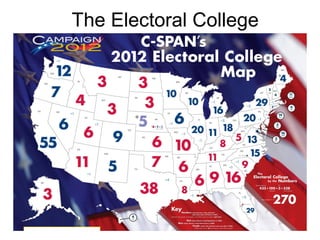
Electoral college 2014
- 2. True or False? The candidate with the most votes is elected president. Answer: Not necessarily. Ask Al Gore.
- 3. Why an Electoral College? • The Founding Fathers felt an EC was necessary for a few reasons: • They questioned whether the voters were capable of selecting an adequate leader for the nation if the people chose the “wrong” President, the EC could override the vote.
- 4. Historical Background • The framers of the Constitution disagreed on how to elect a president— congressional selection or direct popular election. • The electoral college was a compromise, combining features of both approaches.
- 5. Why an Electoral College? • Voters had very little knowledge of candidates outside of their local area or state voting was based primarily on REGION
- 6. The Electoral College and Federalism The electoral college also reflects the federal nature of the Constitution because it ensures that the states have a role in selecting the president.
- 7. Step 1: Popular Vote • On election day, voters choose who they want to be President & Vice President • What we’re actually choosing are ELECTORS who represent the political party of the candidate we like • These electors are then supposed to vote for the candidate that wins the popular vote in a given state
- 8. State Electoral Votes Each state gets as many electoral votes as the sum of its representation in the U.S. House and Senate Texas: 32 House members plus 2 senators = 34 electoral votes Connecticut: 5 House members plus 2 senators = 7 electoral votes Total: 435 House members plus 100 senators plus 3 electors for the District of Columbia = 438 electoral votes
- 9. Step 2: “Winner Take All” • The EC system is “winner take all.” • That is, the candidate with the most popular votes gets ALL of the electoral votes (except in Maine and Nebraska where the electoral votes can be divided)
- 10. Step 3: Counting the Votes • The electors then meet in the State capitol to cast votes for the candidate they represent (Monday after the 2nd Wednesday in December). • Those votes are then sent to the president of the Senate in DC • The president of the Senate counts the votes on January 6 (this is done before Congress)
- 11. What if There Is A Tie (or if no one wins)? • If no Presidential candidate gets 270 electoral votes, the US House of Representatives takes a vote to determine the winner (this happened in 1800 & 1824) • If no Vice Presidential candidates receives enough votes to win, the Senate takes a vote to decide who the winner is (this happened in 1837). Richard M Johnson
- 12. Criticisms of the Electoral College • The popular vote winner may lose the presidency. • Electors may vote for persons other than their party’s presidential and vice presidential candidates. • If no candidate receives a majority, Congress will pick the president and vice president.
- 13. Political Legitimacy Political legitimacy is the popular acceptance of a government and its officials as rightful authorities in the exercise of power.
- 14. Political Legitimacy and the Electoral College The proponents of the electoral college believe that it conveys legitimacy to the winner in most closely fought presidential elections. For example, Bill Clinton won 69 percent of the electoral vote in 1992 despite capturing only 43 percent of the popular vote. The electoral college gave Clinton the appearance of the majority support necessary to be an effective president.
- 15. Flaws of the Electoral College
- 16. #1: It’s possible to win the popular vote but lose the electoral vote • 1824 Andrew Jackson (41.3% of the popular votes, John Quincy Adams 30.9% of the popular vote) – Jackson received 99 of 261 electoral votes more than any other candidate but not enough to win
- 18. 1876 • Samuel J. Tilden – 4,288,546 popular votes – 184 electoral votes • Rutherford B Hayes – 4,034,311 popular votes – 185 electoral votes
- 20. 1888 • Grover Cleveland – 5,534,488 popular votes – 168 electoral votes • Benjamin Harrison – 5,443,892 popular votes – 233 electoral votes
- 22. 2000 • Al Gore – 50,992,335 popular votes – 266 electoral votes • George W Bush – 50,455,156 (537,179 votes less) – 271 electoral votes • Florida was decided by only 537 votes!
- 25. #2: Electors Don’t Have to Do What We Tell Them To • Electors have refused to vote for their party’s nominee – 1796 – 1820 – 1948 – 1956 – 1960 – 1968 – 1972 – 1976 – 1988 – 2000 – 2004 an elector from MN voted for John Edwards (twice, Pres & VP)
- 26. The contest could be decided by the House • Problem: The voting is not done by members of the House but by state. • Why is that a problem? • A state could lose its votes if no candidate received a majority • If a 3rd party candidate were involved, the vote could be divided and no one would be declared winner by January 20
- 27. Proposals for Reform • Eliminate electors but still count electoral votes. • Select electors based on the proportion of the vote each candidate gets in each state. • Select electors by congressional districts with two electors chosen at large in each state. • Choose the president by direct popular election.
- 28. Will Reform Happen? • Amending the Constitution is not easy. • Small states would be opposed to reform because they benefit from the current system. • Groups that are concentrated in states with large numbers of electoral votes (such as Cuban Americans, Jewish Americans, urban residents, etc.) would be opposed to reform because it would diminish their influence.
